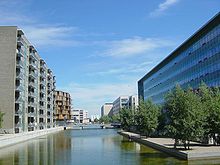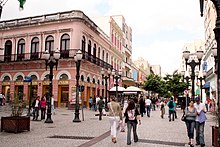Transit-oriented development
This article needs additional citations for verification. (October 2007) |
The examples and perspective in this article may not represent a worldwide view of the subject. (January 2012) |
 |
 |

A transit-oriented development (TOD) is a mixed-use residential or commercial area designed to maximize access to public transport, and often incorporates features to encourage transit ridership. A TOD neighborhood typically has a center with a transit station or stop (train station, metro station, tram stop, or bus stop), surrounded by relatively high-density development with progressively lower-density development spreading outward from the center. TODs generally are located within a radius of one-quarter to one-half mile (400 to 800 m) from a transit stop, as this is considered to be an appropriate scale for pedestrians.
Many of the new towns created after World War II in Japan, Sweden, and France have many of the characteristics of TOD communities. In a sense, nearly all communities built on reclaimed land in the Netherlands or as exurban developments in Denmark have had the local equivalent of TOD principles integrated in their planning, including the promotion of bicycles for local use.
Transit-oriented development is sometimes distinguished by some planning officials from "transit-proximate development" (see, e.g. comments made during a Congressional hearing [2]) because it contains specific features that are designed to encourage public transport use and differentiate the development from urban sprawl. Examples of these features include mixed-use development that will use transit at all times of day, excellent pedestrian facilities such as high quality pedestrian crossings, narrow streets, and tapering of buildings as they become more distant from the public transport node. Another key feature of transit-oriented development that differentiates it from "transit-proximate development" is reduced amounts of parking for personal vehicles.
TOD in cities
Many cities throughout the world are developing TOD policy. Portland, Montreal, San Francisco, and Vancouver among many other cities have developed, and continue to write policies and strategic plans which aim to reduce automobile dependency and increase the use of public transit.
Latin America
Guatemala City, Guatemala
In an attempt to control rapid growth of Guatemala City, the long-time Mayor of Guatemala City Álvaro Arzú implemented a plan to control growth based on transects along important arterial roads and exhibiting transit-oriented development (TOD) characteristics. This plan adopted POT (Plan de Ordenamiento Territorial) aims to allow the construction of taller, mixed-use building structures right by large arterial roads; the buildings would gradually decrease in height and density the farther they are from arterial roads.[3] This is simultaneously being implemented along with a bus rapid transit (BRT) system called Transmetro.
Curitiba, Brazil

One of the earliest and most successful examples of TOD is Curitiba, Brazil.[4] Curitiba was organized into transport corridors very early on in its history. Over the years, it has integrated its zoning laws and transportation planning to place high-density development adjacent to high-capacity transportation systems. Since the failure of its first, rather grandiose, city plan due to lack of funding, Curitiba has focused on working with economical forms of infrastructure, so it has arranged unique adaptations, such as bus routes (inexpensive infrastructure) with routing systems, limited access and speeds similar to subway systems. The source of innovation in Curitiba has been a unique form of participatory city planning that emphasizes public education, discussion and agreement.
North America
San Francisco, CA Bay Area
The San Francisco Bay Area includes nine counties and 101 cities, including San Jose, San Francisco, Oakland and Fremont. Local and regional governments [5] encourage transit-oriented development to decrease traffic congestion, protect natural areas, promote public health and increase housing options. The region has designated Priority Development Areas and Priority Conservation Areas. Current population forecasts [6] for the region predict that it will grow by 2 million people by 2035 due to both the natural birth rate and job creation, and estimate that 50% of this growth can be accommodated in Priority Development Areas through transit-oriented development.
Major transit village projects have been developed over the past 20 years at several stations linked to the Bay Area Rapid Transit (BART) system. In their 1996 book, Transit Villages in the 21st Century, Michael Bernick and Robert Cervero identified emerging transit villages at several BART stations, including Pleasant Hill / Contra Costa Centre, Fruitvale, Hayward and Richmond.[7]
Vancouver, BC
Greater Vancouver has had a strong history of creating new development around its SkyTrain lines and also created the concept of regional town centres around the major stations and transit corridors. Of note is the Metrotown area of the suburb of Burnaby, British Columbia near the Metrotown SkyTrain Station. The areas around stations have spurred the development of billions of dollars of high-density real estate, with multiple highrises near the many stations.
Toronto, ON

Toronto has a longstanding policy of encouraging new construction along the route of its primary Yonge Street subway line. Most notable are the development of the Yonge and Eglinton area in the 1960s and 1970s; and the present development of the 2 km of the Yonge Street corridor north of Sheppard Avenue, which began in the late 1980s. In the period since 1997 alone the latter stretch has seen the appearance of a major new shopping centre and the building and occupation of over twenty thousand new units of condominium housing. Since the opening of the Sheppard subway line in 2002, there is a condominium construction boom along the route on Sheppard Avenue East between Yonge Street and Don Mills Road.
Calgary, AB

Calgary is home to a very successful TOD community called The Bridges, located in the community of Bridgeland. The Bridges is home to a diverse range of condos, shops, services, and parks. Some other TODs currently being constructed are London and Westbrook, both high rise condo and retail communities in suburban areas of the City. The City continues to create TOD policy for other Calgary communities. Calgary City Council has allocated funding for the creation of six Station Area Plans around the city, to guide increasing development pressure around some of the light rail transit stations. On June 9, 2008, Calgary City Council approved the first station area plan in Calgary's history.
Edmonton, AB
Most of the suburban high rises were not along major rail lines like other cities until recently, when there has been incentive to do so. Century Park is a growing condo community in southern Edmonton at the south end of Edmonton's LRT. It will include low to high rise condos, recreational services, shops, restaurants, and a fitness centre. Edmonton has also had a transit-proximate development for some time in the northeastern suburbs at Clareview which includes a large park and ride, and low rise apartments among big box stores and associated power center parking. Edmonton is also looking into some new TODs in various parts of the city. In the northeast, there are plans to redevelop underutilized land at two sites around existing LRT, Fort Road and Stadium Station.[8][9] In the west, there is plans to have some medium density condos in the Glenora neighbourhood along a future LRT route as well as a TOD in the southeast in the Strathearn neighbourhood along the same future LRT on existing low rise apartments.
Montreal, QC
According to the Metropolitan Development and Planning Regulation[10] of late 2011, 40% of new households will be build as TOD neighbourhoods.
Aurora, CO
The city has developed within its plan as of 2007 standardization measures. For instance, streets' width has been set according to the position of the site[11][12].
Asia and Oceania
Hong Kong
In the mid-20th century, no railway was built until an area was well developed. However, in recent decades, Hong Kong has started to have some TODs, where a railway is built simultaneously with residential development above or nearby. Examples include:
Melbourne, Australia
Melbourne, Australia, the fastest growing settlement in Australia, is expected to reach a population of 5 million by 2030 with the overwhelming majority of its residents relying on private automobiles. Since the turn of the century, sporadic efforts have been made by various levels of government to implement transit-oriented development principles. However, a lack of commitment to funding public transport infrastructure, resulting to overcrowding and amending zoning laws has dramatically slowed progress toward sustainable development for the city.
Europe
The Transit-oriented development, as a US-born concept, is actually not in use in Europe. But this copes with reality of urban planning there, and recently scholars and technicians took interest in the concept[13].
Paris, France
Whereas the city of Paris has a centuries-long history, its main frame dates to this XIXth century. The subway network was made to solve both linkage between the five main train stations and local transportation assets for citizens. The whole area of Paris City is closer than 500 meters from the next subway station. Recent bicycle and car rental systems (Velib and Autolib) ease also transportation, in the very same way that TOD emphasizes.
Stedenbaan, The Netherlands
In the Southern part of the Randstad will be built a neighbourhood according to the principles of TOD[14].
Equity concerns
One criticism of TOD is that it has the potential to spur gentrification in low-income areas. In some cases, TOD can raise the housing costs of formerly affordable neighborhoods, pushing low- and moderate-income residents farther away from jobs and transit. When this happens, TOD projects can disrupt low-income neighborhoods.[15] When executed with equity in mind, however, TOD has the potential to benefit low- and moderate-income (LMI) communities: it can link workers to employment centers, create construction and maintenance jobs, and has the potential to encourage investment in areas that have suffered neglect and economic depression.[16] TOD also reduces transportation costs, which can have a greater impact on LMI households since they spend a larger share of their income on transportation relative to higher-income households. This frees up household income that can be used on food, education, or other necessary expenses. Low-income people are also less likely to own personal vehicles and therefore more likely to depend exclusively on public transportation to get to and from work, making reliable access to transit a necessity for their economic success.[17] Another criticism aims the marginal percentage of people actually using public transportation[18].
See also
- Americas Energy and Climate Symposium
- Auto-oriented development
- Principles of Intelligent Urbanism
- Smart growth
- Streetcar suburb
- Transit-proximate development
- Transit village
- Urban consolidation
- Value capture
References
- ^ http://www.epa.gov/smartgrowth/arlington.htm
- ^ http://edf.org/documents/2698_Testimony03_03.pdf
- ^ ":::... Plan de Ordenamiento Territorial - Tú eres la Ciudad, Municipalidad de Guatemala, cumple ...:::" (in Template:.e icon). Pot.muniguate.com. Retrieved 2009-07-08.
{{cite web}}: CS1 maint: unrecognized language (link) - ^ "Citizine Information, Zoning and Land Use in Curitiba (Ingles)". 2006. Retrieved 2008.
{{cite web}}: Check date values in:|accessdate=(help); Unknown parameter|month=ignored (help) - ^ http://www.bayareavision.org/index.html
- ^ http://www.abag.ca.gov/planning/currentfcst/
- ^ Michael Bernick, Robert Cervero (1996). Transit Villages in the 21st Century. University of California, Berkeley: McGraw Hill.
- ^ "Old Town Fort Road Redevelopment". City of Edmonton. Retrieved 2010-10-21.
- ^ "Stadium Station Transit Oriented Development". City of Edmonton. Retrieved 2010-10-21.
- ^ http://www.voirvert.ca/nouvelles/actualites/un-premier-plan-d%E2%80%99amenagement-durable-pour-le-grand-montreal
- ^ https://www.auroragov.org/stellent/idcplg?IdcService=SS_GET_PAGE&nodeId=621
- ^ http://www.epa.gov/smartgrowth/codeexamples.htm#street
- ^ https://www.colloquium.fr/ei/cm.esp?id=565&pageid=_3ET0UVLVD
- ^ http://www.thinkdeep.nl/documents/Papers/Hoeven.pdf
- ^ "Equitable Development Toolkit: Transit Oriented Development" (PDF). 2008.
- ^ Federal Reserve Bank of San Francisco (2010). "Community Investments: Transit-Oriented Development".
- ^ Federal Reserve Bank of San Francisco (2010). "Equipping Communities to Achieve Equitable Transit-Oriented Development".
- ^ http://www.fogcityjournal.com/wordpress/1638/what-is-transit-oriented-development-supposed-to-be/
